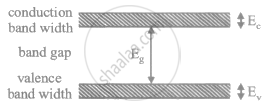Advertisements
Advertisements
प्रश्न
An electric field is applied to a semiconductor. Let the number of charge carries be nand the average drift speed by v. If the temperature is increased,
पर्याय
both n and v will increase
n will increase but v will decrease
v will increase but n will decrease
both n and v will decrease.
उत्तर
n will increase but v will decrease
As we increase the temperature, additional electron‒hole pairs are created in a semiconductor. As a result, the number of charge carriers increases.
Now, drift velocity ( vd) is given by
`vd =(-eEr)/m`
As the temperature increases, the relaxation time of charge carriers (T) decreases. As a result, vd decreases.
APPEARS IN
संबंधित प्रश्न
There are energy bands in a solid. Do we have really continuous energy variation in a band ro do we have very closely spaced but still discrete energy levels?
The conduction band of a solid is partially filled at 0 K. Will it be a conductor, a semiconductor or an insulator?
Electric conduction in a semiconductor takes place due to
When an impurity is doped into an intrinsic semiconductor, the conductivity of the semiconductor
An incomplete sentence about transistors is given below:
The emitter−..... junction is __ and the collector−..... junction is __. The appropriate words for the dotted empty positions are, respectively,
The impurity atoms with which pure silicon may be doped to make it a p-type semiconductor are those of
(a) phosphorus
(b) boron
(c) antimony
(d) aluminium.
The conductivity of an intrinsic semiconductor depends on temperature as σ = σ0e−ΔE/2kT, where σ0 is a constant. Find the temperature at which the conductivity of an intrinsic germanium semiconductor will be double of its value at T = 300 K. Assume that the gap for germanium is 0.650 eV and remains constant as the temperature is increased.
(Use Planck constant h = 4.14 × 10-15 eV-s, Boltzmann constant k = 8·62 × 10-5 eV/K.)
A semiconducting material has a band gap of 1 eV. Acceptor impurities are doped into it which create acceptor levels 1 meV above the valence band. Assume that the transition from one energy level to the other is almost forbidden if kT is less than 1/50 of the energy gap. Also if kT is more than twice the gap, the upper levels have maximum population. The temperature of the semiconductor is increased from 0 K. The concentration of the holes increases with temperature and after a certain temperature it becomes approximately constant. As the temperature is further increased, the hole concentration again starts increasing at a certain temperature. Find the order of the temperature range in which the hole concentration remains approximately constant.
(Use Planck constant h = 4.14 × 10-15 eV-s, Boltzmann constant k = 8·62 × 10-5 eV/K.)
With reference to Semiconductor Physics,
Draw a labelled energy band diagram for a semiconductor.
A window air conditioner is placed on a table inside a well-insulated apartment, plugged in and turned on. What happens to the average temperature of the apartment?
If the lattice constant of this semiconductor is decreased, then which of the following is correct?

The energy of a hydrogen atom in the ground state is −13.6 eV. The energy of a He+ ion in the first excited state will be:
A hole in a. p – type semiconductor is
A semiconductor is cooled from T.K to T2K its resistance will
In a common-base circuit calculate the change in the base current if that in the emitter current is αmA and a = 0.98
Draw the energy band diagrams for conductors, semiconductors and insulators. Which band determines the electrical conductivity of a solid? How is the electrical conductivity of a semiconductor affected with rise in its temperature? Explain.
With reference to semiconductor physics, answer the following question.
In which material “Forbidden band” is absent?
